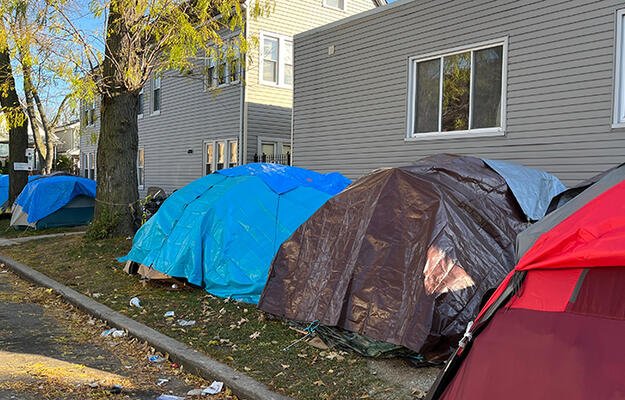
When Moratoria Lift, How Can State and Local Governments Avoid a COVID-19 Eviction Surge?
As part of the Urban Institute’s exploration of policies to protect people and places from the impacts of COVID-19, researchers are examining how state and local governments can respond to the tremendous rental housing challenges presented by COVID-19. In this Housing Matters blog series, we present evidence-based ideas for how state and local leaders can stabilize housing for renters affected by the pandemic and job loss. You can find the framing post with links to each post in the series here.
Before the pandemic, the nation was already in the midst of an eviction crisis that lasted unabated for years. For nearly two decades, property owners in the US filed more than two million eviction cases per year, with about half those filings resulting in completed evictions (this is roughly the rate of completed foreclosures during the height of the foreclosure crisis). Income loss because of COVID-19 puts millions more renters at risk of falling behind. Eviction moratoria are among the tools that federal, state, and local governments are using to stabilize both small and large subsets of renters during the pandemic, but moratoria are merely a pause. And in many places, that pause recently ended or will end soon. Meanwhile, the rent bills keep piling up.
Despite a national rent payment tracker indicating that most renters continue to pay all or part of the rent, the majority of renters—including those in single-family homes—are not in properties that contribute to the dataset. A nationally representative survey conducted early in the pandemic found that nearly half of working-age renters were facing material hardship, and 14 percent either did not pay the rent or were late.
Eviction moratoria play an essential role in keeping renters housed while policymakers identify ways to resolve eviction risks and stabilize rental markets. Regardless of whether a city or state extends its eviction moratorium, as the federal government recently did, now is the time to grapple with what comes next.
When moratoria are lifted, how can state and local governments reduce the number of eviction cases in the courts (or divert cases already in the courts) and prevent a surge? And what legal protections could enable eviction diversion efforts to succeed?
Preventing and diverting evictions
Court eviction cases are likely to surge when moratoria end because of substantial gaps in emergency assistance and unemployment benefits. This would be devastating for renters, landlords relying on rent revenue, rental markets, overloaded court dockets, and communities. But we’ve learned from the eviction crisis that came before COVID-19 that when renters have access to a combination of lawyers, mediators, and emergency financial assistance, they can successfully defend themselves, negotiate a settlement, or pay the arrears and keep their homes. For example, a court-based clinic in Saint Paul brings lawyers, mediators, and financial assistance providers together in the courthouse to prevent evictions. Since the clinic started, the county has reduced eviction judgments and increased expungements, and the court spent just an hour extra on the initial hearings each week and had fewer cases go to trial.
The idea of eviction diversion—reducing the number of eviction cases that enter or continue through the pipeline—has much in common with approaches adopted during the foreclosure crisis. For example, in the foreclosure crisis, the federal government created financial relief programs to prevent housing loss, while states both distributed portions of the federally funded relief and adopted mediation programs to seek effective resolution of cases outside of court. Although the relief funding was essential in reducing foreclosures, a multi-site evaluation [PDF] found that homeowners were more likely to retain their homes if they participated in mediation and received legal services and/or housing counseling.
By requiring or automatically scheduling mediation in evictions and facilitating access to complementary services from lawyers, housing counselors, or financial assistance providers, states can likewise get renters and landlords into the same room (physically or virtually) to seek a mutually beneficial agreement. Most states that adopted foreclosure mediation had a judicial foreclosure process, in which foreclosures required court action and courts could refer incoming cases to mediation before a final ruling. For nonpayment of rent evictions, states already rely on court filings and, therefore, could adopt a similar approach. Courts that do not yet have partnerships with mediation providers can use the current pause to find a mediation partner, such as a member of the National Association for Community Mediation or a law school with an alternative dispute resolution program.
Eviction diversion programs in North Carolina and Michigan encourage diversion before or after a court filing through emergency rent assistance, and a program set to launch in Virginia would enable the conversion of nonpayment filings into repayment agreements. The experience in Saint Paul, however, shows the value of adding legal knowledge and mediation skills for eviction diversion. Each has valuable skills and knowledge that can ensure tenants or emergency assistance providers only pay the amounts truly due and that each party’s needs are heard and incorporated in any settlement.
Building a supportive legal environment
When moratoria end, what comes next depends on how robust the moratorium was, what remedies were enacted during the pause, and the underlying legal environment. Just as each moratorium is different, each state (and sometimes county or city) has different tenant-landlord laws and eviction processes. Reviewing the legal environment can help showcase ways for state and local actors to enable eviction diversion to have the greatest chance of success.
- Offer or require mediation to reduce eviction filings. Unless explicit protections are in place, such as notice and opportunity to catch up on missed rent payments, most landlords will be able to proceed with an eviction as soon as a moratorium is lifted. The mere act of filing an eviction can damage renters’ future housing prospects, even if they are able to work out alternatives to eviction. State and local governments can avoid this by requiring mediation before accepting a new eviction case. In addition to preserving a tenant’s rental record, when mediation or other eviction diversion approaches prevent a court filing, it benefits the court by reducing the caseload (and perhaps court costs) and benefits landlords and tenants by reducing the fees paid by landlords (and ultimately passed along to tenants).
- Improve legal protections to reduce eviction judgments. After an eviction filing, renters need sound legal advice and related supports to retain stability. A right to counsel [PDF] or expanded access to legal services can reduce judgments for eviction, according to evaluations in multiple cities. A consultation with a lawyer followed by screening for emergency assistance eligibility and access to mediation can also reduce evictions. Other legal rights and defenses can further improve the resolution of cases. For example, a right of redemption (that is, the ability to stop the eviction process by paying the arrears) would ensure that evictions only occur if the rent remains unpaid, while allowing renters to present habitability defenses in an eviction hearing would protect the public interest in health, housing stability, and consumer protection in contract matters.
- Enable expungement to prevent lasting harm. To ensure a resolved eviction filing does not create a negative court record, state legislation can allow (and courts or local service providers can facilitate) the sealing or expungement of eviction cases. Laws may automatically seal all cases after a certain period of time or may allow the expungement of cases that were without merit or in which both parties agree to expungement. Since tenant screening reports may treat an eviction filing negatively even if the case did not end in a judgment to evict, legislators may also enable the sealing of cases at the moment of filing and only allow the record to become public if it ends in a judgment for the landlord. Oversight by attorneys general could enforce remedies in the event of improper use of sealed eviction records.
- Improve judicial expertise in housing to protect renters’ and landlords’ rights. The complexity of eviction cases and the rules related to moratoria call for specialized housing knowledge, even under normal circumstances. Assigning a dedicated judge or referee to eviction cases could enable the court to apply greater expertise in the nuances of local landlord-tenant law and better assess the merits of a case. In places that already take this approach (or have a specialized housing court), judges will know if an expired eviction moratorium banned late fees or had other particularities to watch for. Areas with a specialized housing court can also more readily implement postfiling eviction diversion to offer services efficiently to people entering the court for a hearing. Although the process of creating a housing court in Hennepin and Ramsey Counties, Minnesota, took three years from law to implementation, assigning common staff to housing cases may be quicker to adopt.
Given the urgent public health risks from COVID-19, many states and localities paused evictions—at least among people who newly faced eviction because of the pandemic. The immediacy of the economic crisis then led to efforts to add emergency rent assistance tools and strengthen state and local capacity to distribute federal relief funds. Yet, eviction prevention mediation programs and supportive legal environments can supplement these essential funds and further contain the crisis. Rent assistance, mediation, and legal assistance all reduce the number of nonpayment cases on the court docket and help resolve filings in ways that keep renters, landlords, and rental markets afloat. If courts and mediation providers are anxiously anticipating an eviction surge, their hands are not tied. Working together to improve access to eviction mediation both virtually and via the courts, state legislators, county court officials, and mediation providers can get ahead of the surge and reduce the damage.
Solomon Greene advised on this blog post and contributed to both framing and research. Jorge Morales-Burnett provided additional research support. I am grateful for additional input from Monique King-Viehland, Megan Hatch, John Pollock, Sophie House, Emily Benfer, and Mary Cunningham.
Photo by Air Images/Shutterstock


